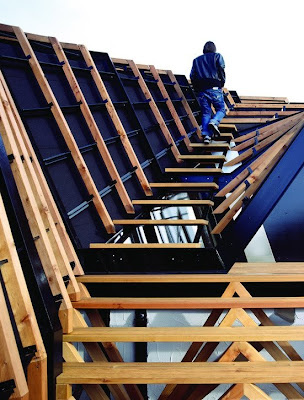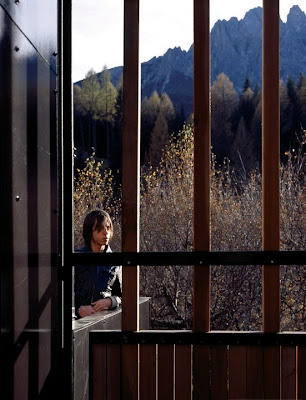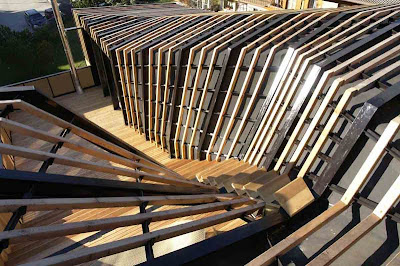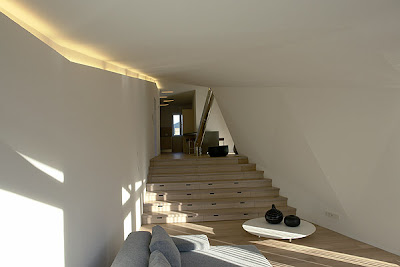The project has been developed as a parasite which started from adopting the structure of the host and gradually differentiated into its own unique organization and morphology.
The project is formed by a series of steel and timber frames that deform to recreate the smooth hillsides of the surrounding dolomites. This partly accessible roofscape also determines the spatial character inside- the spaces are enfolded by an angular and dynamic series of planes creating new and ever-changing perspectives and spatial constellations.
The unique stratified morphology and construction system started off from projecting each step of the external staircase as a modulor that then was proliferated as frames. These frames enable the subsequent deformation and softening of the overall geometry.
The split level organization leads to the lengthening of parts of the stairs to form a topography for informal occupation. The overall spatial character is that of an echelon with a diffusion of functions and conditions where inside and outside, above and below become gradient zones of varying intensity. These interleave as a loop that transgresses from the most private zone of bedroom and bathroom via kitchen, dining and living rooms towards the more public and exposed territory of the various terraces.
The interior spaces are the reflection of the exterior geometry with folded planes accentuating the flow through the open split-level plan.Their character is determined by the transgressions from the Cartesian orthogonal layout (determined in part by the structure below and functional requirements) towards the soft and fluid morphology of the roofscape.
The split level organization leads to the lengthening of parts of the stairs to form a topography for informal occupation. The overall spatial character is that of an echelon with a diffusion of functions and conditions where inside and outside, above and below become gradient zones of varying intensity. These interleave as a loop that transgresses from the most private zone of bedroom and bathroom via kitchen, dining and living rooms towards the more public and exposed territory of the various terraces.
The interior spaces are the reflection of the exterior geometry with folded planes accentuating the flow through the open split-level plan.Their character is determined by the transgressions from the Cartesian orthogonal layout (determined in part by the structure below and functional requirements) towards the soft and fluid morphology of the roofscape.
Site, program and organization
To consider building a new dwelling on top of an existing house is a relevant and valuable approach, leaving ground undeveloped elsewhere and creating higher density. Plasma’s process of charging each project from its ground and context becomes here even more specific. The existing house is composed of two parts with different levels. Structural walls, chimneys, drainage and other infrastructural lines organized the site into a mesh of constraints.
We challenged the standard pitched and overhanging roof and instead developed a rich texture of different occupiable spaces.
On the outside these are a podium that leads to the top of the roof within a dip, a semi-covered pergola beneath it, a long terrace as extension to the south of the living room.
Design process
Given that the existing house has two ‘wings’ with different roof levels, we started from a simple diagram of two boxes forming a ‘T’, allowing plenty of external space for terraces to the South.
The lower Western box became the living zone with the upper Eastern box to contain the master bedroom, bathroom, 2nd bedroom and kitchen.



Bringing the access as external staircase along the North side enabled the definition of the entrance along the seam between the two zones creating a hinge area for distribution.
From this external staircase the rhythm of each step was then proliferated as frames that became deformed to produce a soft intertwining of roof and walls as continuous artificial topography.
This produces a variety of outdoor environments for sitting on the roof and enjoying great views all around or beneath sheltered from wind and sun.
Tectonics and construction
The conceptual and geometric striation was translated into a series of outside steel belts from which prefabricated composite wall/ceiling panels are suspended. Small T-sections span in perpendicular direction to the major steelwork to support the additional timber sections that complete the outer layer.
All the different systems are interdependent and it was vital to work with a specialist contractor that was able to produce all fabrication information directly from our 3D computer model.
Architects: Plasma Studio
Location: Innichen, San Candido, Italy
Project Year: 2006
Principals: Arch. Eva Castro, Arch. Holger Kehne, Arch Ulla Hell
Collaborators: Arch. Peter Pichler, Arch. Angelika Mair, Libny Pacheco
Contractor: Tschurtschenthaler Werner GmbH
Interior Area: 115 sqm
Terraces Area: 55 sqm
Photographs: Cristobal Palma














































0 comments:
Post a Comment